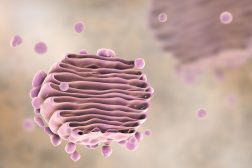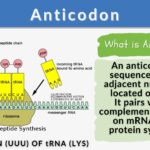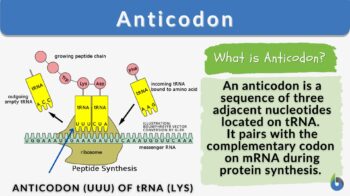
Anticodon
n., plural: anticodons
[ˌæntiˈkəʊdɒn]
Definition: A sequence of three adjacent nucleotides located on one end of transfer RNA
Table of Contents
The anticodon is a special code on tRNA that matches up with the instructions on the mRNA thus making sure that the right/correct/particular amino acid is incorporated. We all are aware of the specific bindings of different molecules or components in the biological world like enzyme-substrate, antibody-antigen, codon-anticodon, etc.
While the enzymes bind to specific molecules called substrates to catalyze their conversion into products, we have come to know this interaction as a “lock-and-key interaction”. On the other hand, antibodies bind to antigens with high specificity to recognize and neutralize them, hence playing an essential role in immune responses. However, when it comes to base pairing, what transpires is somewhat different from these interactions. Pairing occurs between complementary nucleobases rather than a physical fit like a lock and key. Nevertheless, similar to these molecular interactions, base pairing involves a high degree of specificity.
In the intricate process of protein synthesis, the messenger RNA (mRNA) molecules contain codons, which are RNA sequences of three nucleotides. These codons are essential as they are specifically recognized by complementary anticodons found on transfer RNA (tRNA) molecules. The interaction between codons and anticodons is crucial for accurately incorporating the correct amino acids into the developing protein chain during the translation process. This specific recognition ensures the fidelity and integrity of protein synthesis within the cell. In this module, we will discuss in detail the intricacies of the anticodon, its structure, types, examples, etc.
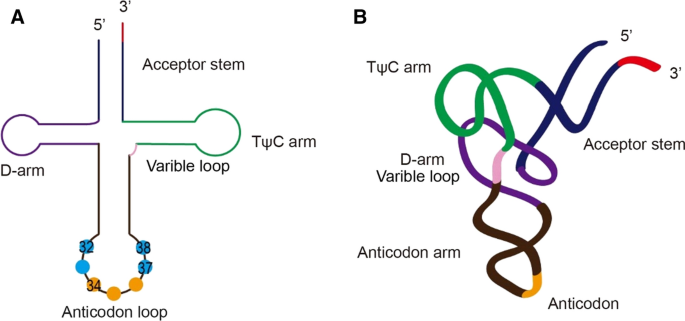
Anticodon Definition
In our cells, there are tiny molecules called transfer RNA (tRNA) that aid the protein synthesis process. Proteins are essential macromolecules for our body’s functions. The mature tRNA carries building blocks called amino acids to a special place where proteins are made.
Now, inside our cells, we have another type of molecule called messenger RNA (mRNA). The mRNA carries a set of instructions for making a protein. These instructions are in the form of 3-letter codes called codons.
The anticodon is defined as the matching code located on the tRNA. It is made up of three “letters” that match the codon on the mRNA. This pairing is like a lock and key in terms of specificity wherein it makes sure that the right one amino acid is brought to the growing protein chain.
For example, let’s say the codon on the mRNA is UAC (Uracil-Adenine-Cytosine). The anticodon on the tRNA that matches with it is AUG (Adenine-Uracil-Guanine). When these two match up, it means the tRNA is carrying the specific amino acid that is needed to build the protein at that point. So, the anticodon’s job is to find the right codon on the mRNA and bring the correct amino acid to make sure the protein is built correctly. It’s like a translator that “helps the cell read the instructions and put the right building blocks in the right places”.
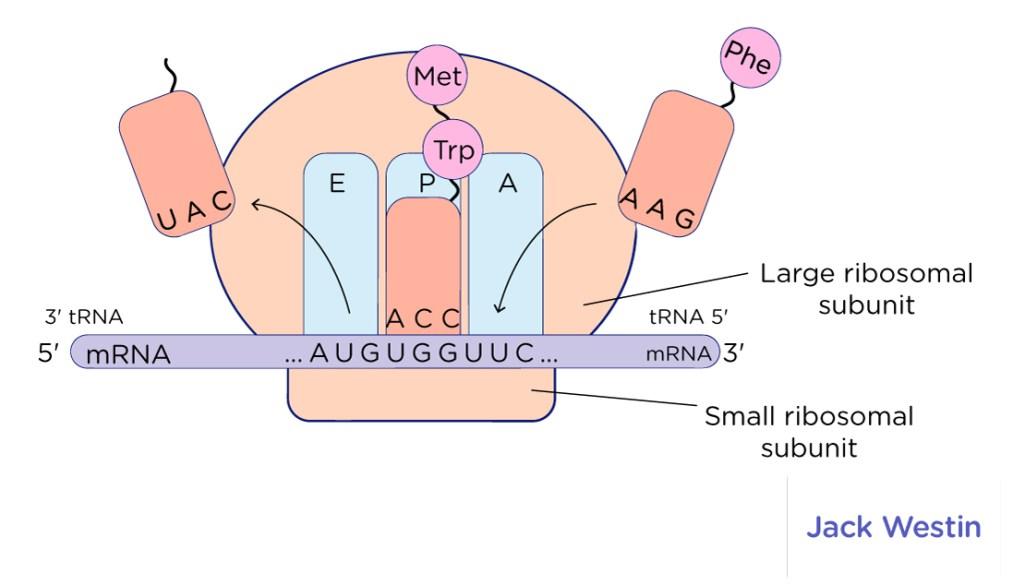
Watch this vid about anticodon:
Biology definition:
An anticodon is a molecular part of the transfer RNA (tRNA) made up of three adjacent nucleotides. It binds to the complementary coding triplet of nucleotides (called a codon) in messenger RNA during the translation phase of protein synthesis.
Anticodons possess an astonishing potential for diversity and specificity, allowing them to accurately decode the genetic code by recognizing and pairing with complementary codons on messenger RNA. For example, the anticodon for glycine is CCC (cytosine-cytosine-cytosine) which binds to the codon GGG (guanine-guanine-guanine) of mRNA.
Function Of Anticodons
The first position of the anticodon on tRNA matches the third position of the codon. Why third? It is because the pairing of the tRNA anticodon with the mRNA codon proceeds from the 5′-3′ direction of mRNA.
To objectively list the functions of the anticodon, they are as follows:
- Accurate interpretation of the genetic code during protein synthesis
- Proper pairing with the complementary codon on mRNA
- A meticulous selection of the appropriate amino acid-bearing tRNA
- Ensuring the fidelity of translation by preventing errors in protein synthesis
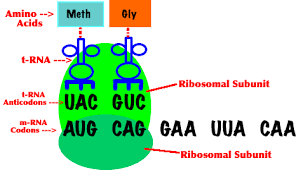
How Anticodons Work
During protein synthesis, the mRNA molecule serves as a carrier of genetic instructions for constructing proteins. It is composed of a sequence of codons and each one consists of three nucleotide bases. These codons act as a code and represent specific amino acids or control signals like start or stop codons. To ensure accurate protein synthesis, tRNA molecules play a vital role.
Each tRNA molecule possesses an anticodon that can recognize and pair with the complementary codon on the mRNA through the process of base pairing. The base pairing rules in this context are similar to those observed in DNA and RNA. In the language of genetics, adenine (A) pairs with uracil (U) in RNA, while cytosine (C) pairs with guanine (G).
These specific base-pairing interactions allow the tRNA anticodon to align precisely with the mRNA codon, enabling the correct amino acid to be incorporated into the growing protein chain. Also, the tRNA modifications can affect the anticodon structure and function which can influence their ability to accurately recognize and pair with complementary codons during protein synthesis.
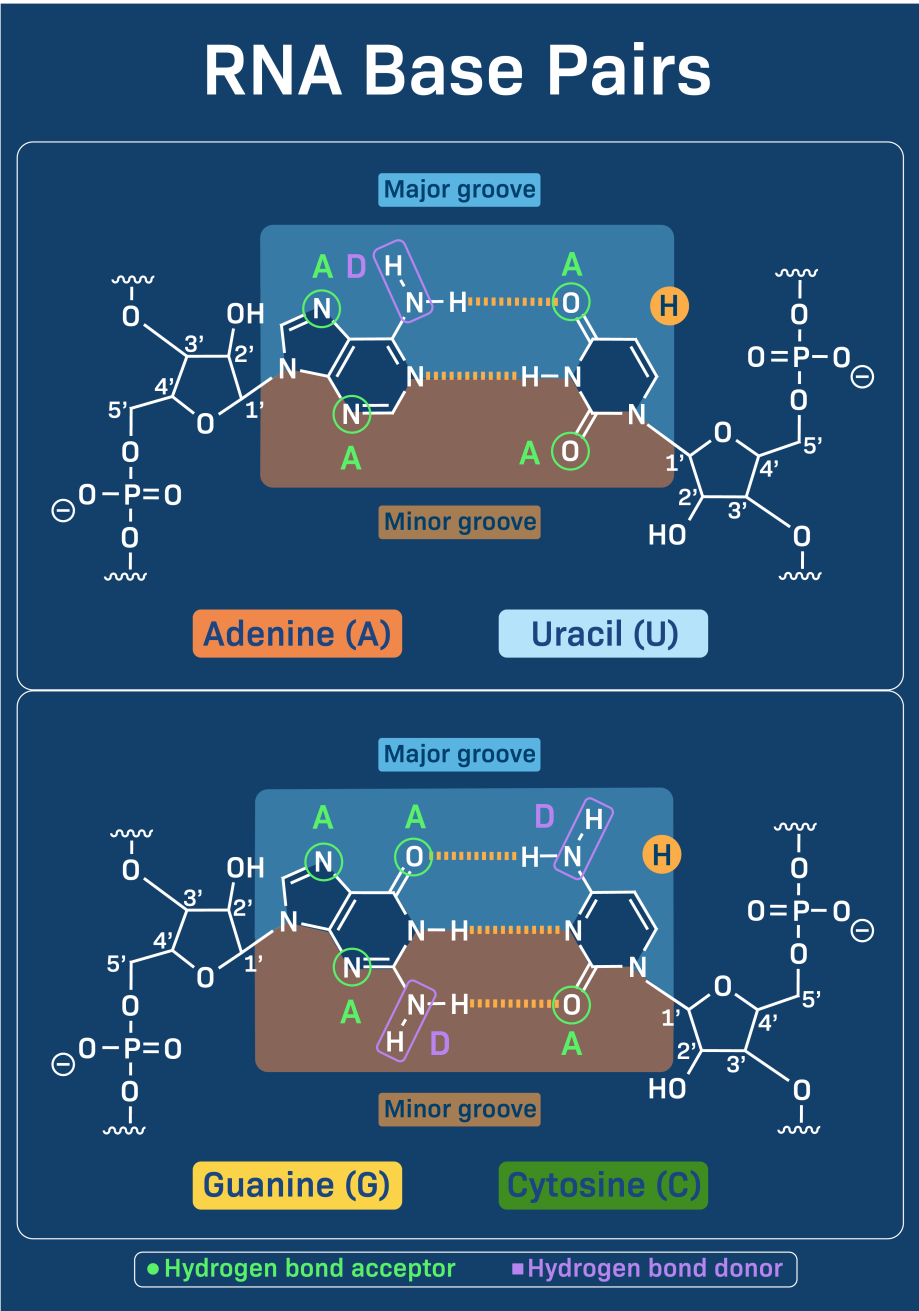
By adhering to these base pairing rules, the genetic code is accurately translated, ensuring that the different amino acids are joined together in the proper sequence, ultimately giving rise to functional proteins within living organisms.
As the polypeptide chain starts growing, the importance of this accurate pairing of anticodons with codons takes the driver’s seat. In case, if the wrong anticodon were to pair with a codon, an incorrect amino acid would be added to the protein which can potentially lead to functional defects. This is why the anticodon also takes care of the fidelity of translation. It helps in the prevention of errors in protein synthesis by recognizing and binding specifically to the corresponding codon. This not only reduces the likelihood of incorrect amino acids being incorporated into the protein chain but also aids in accurate deciphering of the genetic code; thereby facilitating seamless translation.
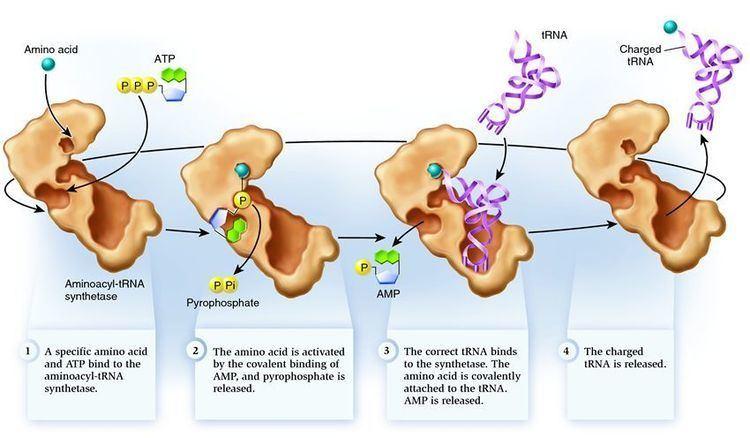
RNA-RNA Base Pairing Rules
The base pairing rules for RNA are like a puzzle where A matches with U and C matches with G. RNA base pairing rules are guidelines that determine how certain letters called nucleotide bases in RNA molecules can fit together. Here are the simple base pairing rules for RNA:
- A (adenine) fits with U (uracil): In RNA, A, and U are like puzzle pieces that go together. They form a pair with each other using two hydrogen bonds.
- C (cytosine) fits with G (guanine): In RNA, C, and G also match up. They form a pair using three hydrogen bonds.
These base pairing rules help RNA molecules to form specific shapes and structures. To understand this quickly, you can think of it as a lock and key system where each base pairs up with its partner to create a stable structure. These structures are important for the RNA molecule to perform its functions inside the cell.
Differences Between RNA And DNA
While there as differences between the base pairing rules for RNA and DNA, there are some similarities like the “complementary pairing of bases” (A with U/T and C with G) using hydrogen bonds which plays critical roles in various cellular processes like transcription, translation, and RNA structure formation. When we discuss the differences between the base pairing rules of RNA and DNA, there are a few notable points as follows:
- Thymine vs. Uracil: In DNA, the base thymine (T) pairs with adenine (A) using 2 hydrogen bonds. However, in RNA, the base thymine is replaced by uracil (U). Uracil (U) pairs with adenine (A) in RNA using the same 2 hydrogen bonds.
- DNA Double Helix vs. RNA Single Strand: DNA is typically found in the form of a double helix, where two complementary DNA strands are intertwined. The base pairs occur between the two strands (A with T and C with G). In contrast, RNA is usually single-stranded, though it can also fold back on itself to form secondary (2°) structures.
- Stability: Due to the presence of thymine, DNA base pairs are generally more stable than RNA base pairs. Thymine forms stronger hydrogen bonds with adenine compared to uracil which contributes to the overall stability of DNA double helix structures.
- RNA Base Pairing in Secondary Structures: RNA can form complex secondary structures like stem loops and hairpins. In these structures, complementary base pairs form between different regions of the same RNA molecule. These interactions contribute to RNA folding and stability.
Examples Of Anticodons
There are several possible anticodons and their corresponding codons, as well as the associated amino acids. We have listed only a few examples below. However, there are more combinations possible, and the specific assignment of amino acids to codons may vary based on the genetic code used by the organism. Commonly we call the tRNA carrying the amino acid (amino acid attached tRNA) by its name like tRNA glu is tRNA taking glutamic acids, tRNA gln is tRNA having glutamine, etc.
Table 1: Table showing different codons and their corresponding anticodons. |
||
|---|---|---|
| Anticodon | Corresponding Codon | Amino Acid |
| UAA | AUU, AUA, AUC | Isoleucine |
| UAC | AUG | Methionine |
| UAG | AUC | Isoleucine |
| UAU | AUA | Isoleucine |
| UCA | AGU, AGC | Serine |
| UCC | AGG | Arginine |
| UCG | AGC | Serine |
| UCU | AGA | Arginine |
| UGA | ACU | Threonine |
| UGC | ACA | Threonine |
| UGG | ACC | Threonine |
| UGU | ACU, ACA, ACC | Threonine |
| UUA | CAA | Glutamine |
| UUC | CAG | Glutamine |
| UUG | CAA, CAG | Glutamine |
| UUU | CAA, CAG | Glutamine |
| CAA | GUU, GUA, GUC | Valine |
| CAC | GUG | Valine |
| CAG | GUC | Valine |
| CAU | GUA | Valine |
| CCA | GGU, GGC, GGG | Glycine |
| CCC | GGG | Glycine |
| CCG | GGC | Glycine |
| CCU | GGA | Glycine |
| CGA | CGU, CGC, CGG | Arginine |
| CGC | CGG | Arginine |
| CGG | CGC | Arginine |
| CGU | CGA | Arginine |
| CUA | GAA | Glutamic Acid |
| CUC | GAG | Glutamic Acid |
| CUG | GAA, GAG | Glutamic Acid |
| CUU | GAA, GAG | Glutamic Acid |
| GAA | CUU, CUA, CUC | Leucine |
| GAC | GUG | Leucine |
| GAG | GUC | Leucine |
| GAU | GUA | Leucine |
| GCA | CGU, CGC, CGG | Arginine |
| GCC | CGG | Arginine |
| GCG | CGC | Arginine |
| GCU | CGA | Arginine |
| GGA | CCU, CCC, CCG | Proline |
| GGC | CCG | Proline |
| GGG | CCC | Proline |
| GGU | CCU | Proline |
| GUA | CAU, CAC, CAA, CAG | Histidine |
| GUC | CAC | Histidine |
| GUG | CAU, CAC | Histidine |
| GUU | CAC, CAA, CAG | Histidine |
| UGC | ACG | Threonine |
| UGG | ACC | Threonine |
| UGU | ACG | Threonine |
| UUA | AAA | Lysine |
| UUC | AAG | Lysine |
| UUG | AAA, AAG | Lysine |
| UUU | AAA, AAG | Lysine |
Data Source: Akanksha Saxena of Biology Online
NOTE IT!
Permutations and Combinations of Anticodons
Did you know that the tiny molecules known as anticodons possess an incredible potential for diversity and specificity?
Anticodons play a crucial role in deciphering the genetic code during protein synthesis. The number of possible permutations and combinations of anticodons is mind-boggling!
Each anticodon consists of three nucleotides. And there are a total of four different nucleotides namely adenine (A), cytosine (C), guanine (G), and uracil (U) that are used to construct the RNA molecules. This opens up a world of possibilities. With three positions that an anticodon has, each position is capable of being filled by any of the four nucleotides. This means the potential number of anticodon combinations is 4 x 4 x 4 = 64.
However, nature’s ingenuity takes it a step further. The genetic code is degenerate. This indicates that multiple codons can code for the same amino acid. This results in a situation where certain anticodons can recognize multiple codons thus expanding their versatility even more.
For instance, let’s take the anticodon UUU. While this anticodon specifically pairs with the codon AAA, which codes for lysine, it can also pair with the codon AAG, which also codes for lysine. This phenomenon, known as wobble base pairing, allows a single anticodon “to wobble” slightly in its specificity and accommodate alternative codons.
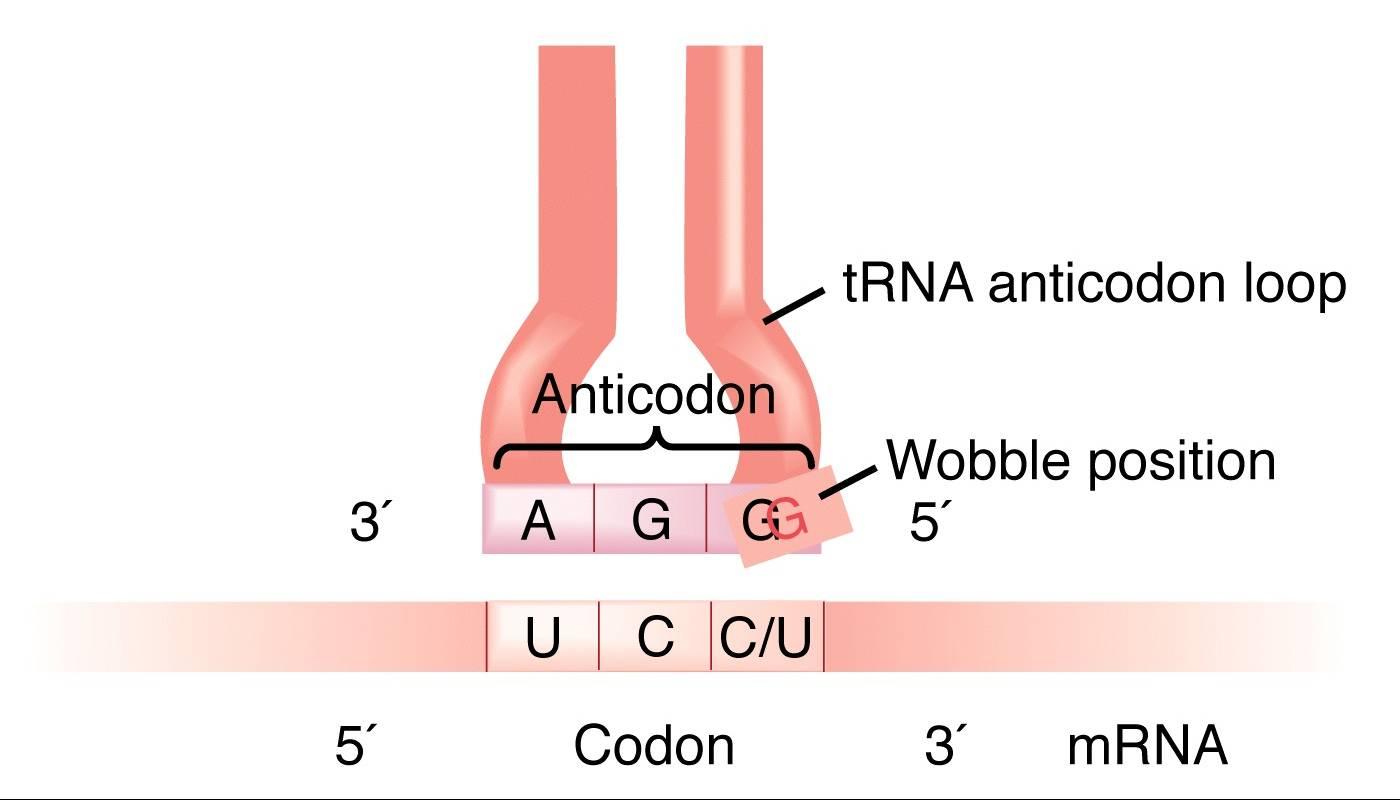
Considering the possible combinations of anticodons, their permutations, and the degeneracy of the genetic code, it’s estimated that there are approximately 61 distinct anticodons responsible for translating the 64 codons. This highlights the exquisite precision and adaptability of the genetic code which allows organisms to synthesize a vast array of proteins from a relatively limited set of genetic instructions.
So, the next time you marvel at the intricacies of protein synthesis, spare a thought for the anticodons; nature’s versatile interpreters that unlock the language of life with their astonishing potential for permutation and combination.
Take the Anticodon – Biology Quiz!
Further Reading
References
- Rubio Gomez, M. A., & Ibba, M. (2020). Aminoacyl-tRNA synthetases. RNA (New York, N.Y.), 26(8), 910–936. https://doi.org/10.1261/rna.071720.119
- Putzer H, Laalami S. Regulation of the Expression of Aminoacyl-tRNA Synthetases and Translation Factors. In: Madame Curie Bioscience Database [Internet]. Austin (TX): Landes Bioscience; 2000-2013. Available from: https://www.ncbi.nlm.nih.gov/books/NBK6026/
- Martinis, S. A., Plateau, P., Cavarelli, J., & Florentz, C. (1999). Aminoacyl-tRNA synthetases: a new image for a classical family. Biochimie, 81(7), 683-700.
- Zhou, JB., Wang, ED. & Zhou, XL. Modifications of the human tRNA anticodon loop and their associations with genetic diseases. Cell. Mol. Life Sci. 78, 7087–7105 (2021). https://doi.org/10.1007/s00018-021-03948-x
©BiologyOnline.com. Content provided and moderated by Biology Online Editors.

